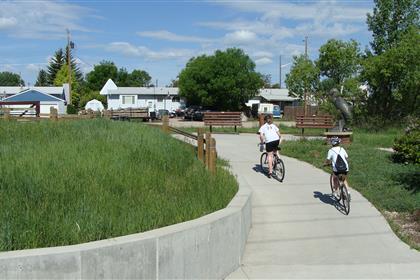
City 2-2-18
The Wyoming Legislature’s Bicycle and Pedestrian Task Force released a final report Tuesday outlining significant benefits for Wyoming communities that improve walking and bicycling options for people. To reap these economic, health, quality of life and safety benefits, the report recommends the state invest $10 million annually in statewide infrastructure for active transportation and recreation.
The recommendation is among a slew of ideas meant to boost the economic and physical health of communities across Wyoming. The State Legislature and Gov. Matt Mead formed the task force in 2016 to study the opportunities, benefits and challenges of bicycle and pedestrian pathways and natural surface trails.
The report is available at wyomingbusiness.org/bicycle.
The task force discovered 4.7 percent of Wyomingites walked or biked to work, which ranks ninth among all states. However, the state only dedicates one percent of its federal transportation dollars to walking and cycling infrastructure, half of the national average. More than 25 Wyoming communities have pathway or trail plans, and 19 participate in the Business Council’s Wyoming Main Street program.
There are about 630 miles of paved pathways in Wyoming, and over 10,000 miles of natural surface trails.
A handful of recommendations for other state agencies includes calling on the
- governor’s office to work with state agencies to implement the Report recommendations, and to work with the Wyoming Delegation and federal land agencies to address the trail maintenance backlog on federal lands.
- Legislature to provide funding and direction to state agencies to prepare a comprehensive and quantitative cost/benefit study of the health, safety, economic, and other benefits of walking and bicycling in Wyoming.
- Wyoming Department of Transportation to create a formal WYDOT Bicycle Pedestrian Program, and to increase investment in infrastructure for people walking and cycling.
- Business Council to offer funding through its Main Street and Business Ready Community programs to improve walking and cycling infrastructure and support vibrant downtowns.
- Wyoming Office of Tourism to promote Wyoming’s downtowns, trail systems, pathways, bicycle routes and long-distance trails.
- Wyoming State Parks improve trail systems in state parks and partner with public lands, and to help develop long-distance bike trails.
- Wyoming Office of State Lands and Investments to identify State Trust Lands where new trail systems could be established and collaborate with local communities on partnerships.
- Wyoming Department of Education to elevate the importance of Safe Routes to School when siting new schools.
The task force’s report also demonstrated some of the latent demand for cycling in Wyoming. For example, visitation at Curt Gowdy State Park tripled after the construction of a mountain biking trail system. Bicycle use along Teton Park Road outside Jackson increased 1,000 percent after the construction of a pathway along the road.
The report shows vibrant downtowns are an important element in diversifying Wyoming’s economy.
This is the first state-level effort of its kind to study these issues in Wyoming and provide recommendations to the legislature and agencies.
The task force will remain available to assist the Legislature and state agencies until July 1, at which time it will disband.
For more information call Tim Young at 307-413-8464.



